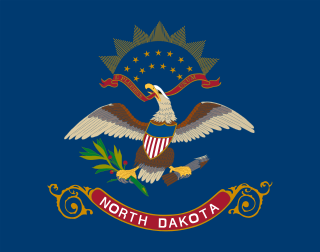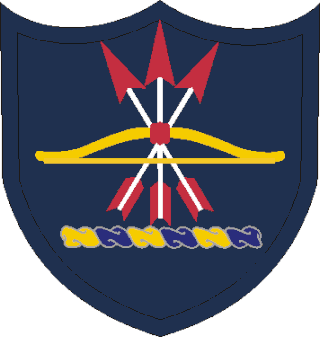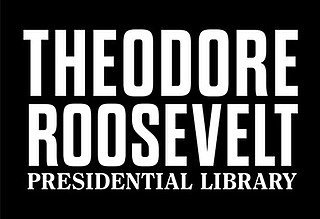
North Dakota is a U.S. state in the Upper Midwest, named after the indigenous Dakota Sioux. It is bordered by the Canadian provinces of Saskatchewan and Manitoba to the north and by the U.S. states of Minnesota to the east, South Dakota to the south, and Montana to the west. North Dakota is part of the Great Plains region, characterized by broad prairies, steppe, temperate savanna, badlands, and farmland. It is believed to host the geographic center of North America, Rugby, and is home to the tallest artificial structure in the Western Hemisphere, the KVLY-TV mast.
A whistle stop or whistle-stop tour is a style of political campaigning where the politician makes a series of brief appearances or speeches at a number of small towns over a short period of time. Originally, whistle-stop appearances were made from the open platform of an observation car or a private railroad car.
The North Dakota University System (NDUS) is the public system of higher education and policy coordination entity in the U.S. state of North Dakota. The system includes all public institutions in the state including two research universities, four regional universities and five community colleges. Community colleges are termed simply colleges in the NDUS system. This convention is unique in that it is one of the minority of states that follow this terminology. The mission of NDUS to enhance the quality of life for all those served by the NDUS as well as the economic and social vitality of North Dakota.
The Music of North Dakota has followed general American trends over much of its history, beginning with ragtime and folk music, moving into big band and jazz. With the development of mass media, local artists in North Dakota, as in the rest of the country, saw a rapid loss of opportunity to create, perform, and sell popular music to the regional audience that had previously provided a market. Punk Music is a major genre in the modern youth scene of North Dakota.

KBMY is a television station in Bismarck, North Dakota, United States, affiliated with ABC and MyNetworkTV. Owned by Forum Communications Company, the station maintains a news bureau and advertising sales office on North 15th Street in Bismarck, and its transmitter is located near St. Anthony, North Dakota.

The 2012 United States Senate election in North Dakota took place on November 6, 2012, concurrently with the 2012 U.S. presidential election, other United States Senate elections, United States House of Representatives elections, and various state and local elections. Incumbent Democratic-NPL Senator Kent Conrad decided to retire instead of running for reelection to a fifth term.

The North Dakota Army National Guard is headquartered at the Fraine Barracks in Bismarck, North Dakota, and consists of the 68th Troop Command, headquartered in Bismarck, and the 141st Maneuver Enhancement Brigade, headquartered in Fargo, North Dakota. Their main installation and armory is at Camp Grafton.

U.S. Highway 2 (US 2) is a 358.090-mile-long (576.290 km) United States Numbered Highway in North Dakota, which runs from the Montana state line east to the Red River at Grand Forks. The route connects the cities of Williston, Minot, and Grand Forks. Of the 358 miles (576 km) of US 2 in North Dakota, all but the westernmost 12 miles (19 km) have four lanes.
The North Dakota High School Boys Hockey program is a high school ice hockey program in the State of North Dakota. The first boys hockey competition took place in 1966-1967 and was won by Grand Forks Central High School.

Aviation in North Dakota takes place around the state's 89 public airfields, including 8 commercial airports. Notable North Dakota aviators include Carl Ben Eielson, Bruce Peterson, and James Buchli.

William F. Kurke (1889–1965) was a prolific architect in North Dakota.

Elizabeth "Jean" Guy was an American First Lady of the U.S. state of North Dakota. The longest serving First Lady in North Dakota's history, she served from 1961 to 1973 during the tenure of her husband, former Governor William L. Guy, the longest-serving governor in the state's history. Described as a highly influential behind the scenes, Jean Guy has been credited with persuading William Guy to run for office, reviving the Democratic Party and the North Dakota Democratic-Nonpartisan League Party in the state during the mid-20th Century.

The 1984 United States presidential election in North Dakota took place on November 6, 1984. All 50 states and the District of Columbia, were part of the 1984 United States presidential election. State voters chose three electors to the Electoral College, which selected the president and vice president of the United States. North Dakota was won by incumbent United States President Ronald Reagan of California, who was running against former Vice President Walter Mondale of Minnesota. Reagan ran for a second time with former C.I.A. Director George H. W. Bush of Texas, and Mondale ran with Representative Geraldine Ferraro of New York, the first major female candidate for the vice presidency.
The state of North Dakota has improved in its treatment of lesbian, gay, bisexual and transgender residents in the late 1990s and into the 21st Century, when the LGBT community began to openly establish events, organizations and outlets for fellow LGBT residents and allies, and increase in political and community awareness.

Douglas James Burgum is an American entrepreneur and politician serving as the 33rd governor of North Dakota since 2016. A member of the Republican Party, Burgum was an angel investor in and the president of Great Plains Software and is a candidate in the 2024 United States presidential election.

The Theodore Roosevelt Presidential Library will be a museum of action celebrating the life and legacy of Theodore Roosevelt, the 26th president of the United States. It is to be constructed at a site to the west of Medora, North Dakota, near Theodore Roosevelt National Park, which preserves sites associated with Roosevelt's sojourn in North Dakota between 1883 and 1887. The project is in planning stages. A site in the Badlands of Medora was selected in 2020, as well as the design architect Snøhetta and the architect of record JLG Architects.









